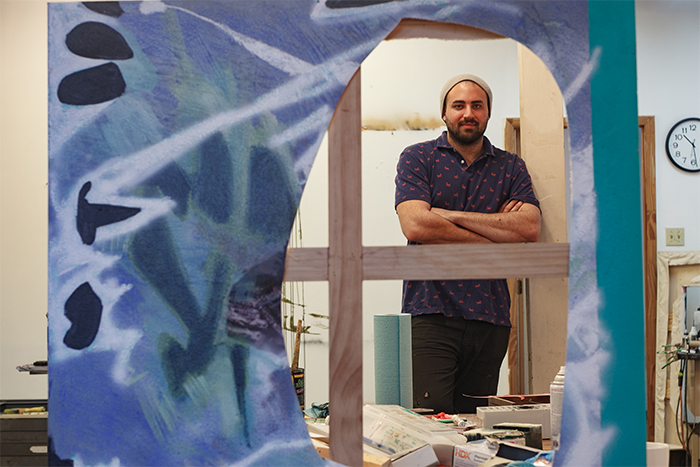Artists, Indoors and Out

Mary Miss discusses her art during her visit to Dickinson. Photo by Carl Socolow '77.
Visiting artists make sustainability tangible, reach into digital realms
by MaryAlice Bitts-Jackson
The New York museum and gallery scene was a tough nut for a woman artist to crack, particularly in the late 1960s, when Mary Miss arrived. So she took her work outside, using public spaces as both canvas and subject to create art that engages passersby in pressing environmental and social issues.
Today, Miss is a celebrated installation artist and founder of an art activism organization. She is one of two visual artists to visit campus this month, meeting with art students and speaking at public events highlighting their work.
The history and ecology of space: Mary Miss
Trained as a sculptor, Miss creates installations that emphasize the history and ecology of a given structure or space and the ways in which the environmental needs within that space can be addressed. A 2012 documentary, Mary Miss: An Interview, features archival footage of her six-decade career. She delivered a public lecture on Thursday, April 14, and also attended a luncheon with students, answering questions about her mission to use art to help effect change around global issues like water and air quality, energy use and access to healthy food. Her residency was sponsored by the Robert H. and Jane Weiner Endowment Fund.
Past projects include a temporary memorial around the perimeter of Ground Zero soon after the attacks of 9/11; an interactive "garden" in Delhi that focused on air quality and health; a walkway across part of the surface of the Hudson River, reminding pedestrians of the natural spaces around them; an installation on water resources in Beijing’s Olympic Park; a series of circular disks marking predicted flood levels in Boulder, Colorado; and an installation highlighting the history of the space occupied by the Union Square subway station.
Miss also developed City as Living Laboratory, an organization that pairs artists with scientists to make sustainability issues tangible to the public through collaborative projects. A current work uses geocaching, mirrors and text to communicate everyone's ability to become environmental stewards in their own neighborhoods.
“These projects aren’t just an artist's riff on an issue; they're the result of an artist collaborating with [a scientist] to make these issues apparent," Miss told the audience during her Thursday evening lecture. "We want to give people ideas about the cities they live in, the systems that support them and new ways of living."
An open studio: Thomas Wharton

Thomas Wharton. Photo by Carl Socolow '77.
While Miss spoke with students about bringing art outdoors, fellow visiting artist Thomas Wharton invited students inside.
Wharton uses traditional and digital tools to create 3- and 2-D works that can include elements from previous projects. "My practice as a painter is both an intervention of art history with digital technology, and an intervention of digital technology with art history," he writes.
The artist is serving a six-week residency that included an open-door studio, allowing all members of the campus community to get an up-close view of his process. He also offered workshops, personal critiques and an exhibition in the Goodyear Gallery. The residency was made possible with support through the Sylvia J. Smith Visiting Artists Fund.
Both Wharton and Miss encouraged students to use their artistic voices to help others view themselves and their world afresh.
“There’s something we, as artists, have to offer—an emotional, psychological and visceral engagement in the issues—and it’s an essential role that they can take on in the public realm,” Miss said. “I feel so passionately that we all, whatever our role, have agency and can effect change.”
Learn more
Published April 19, 2016